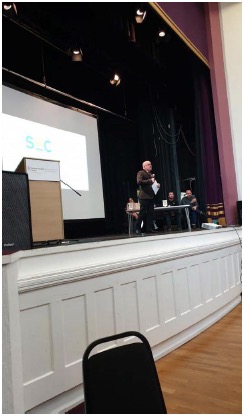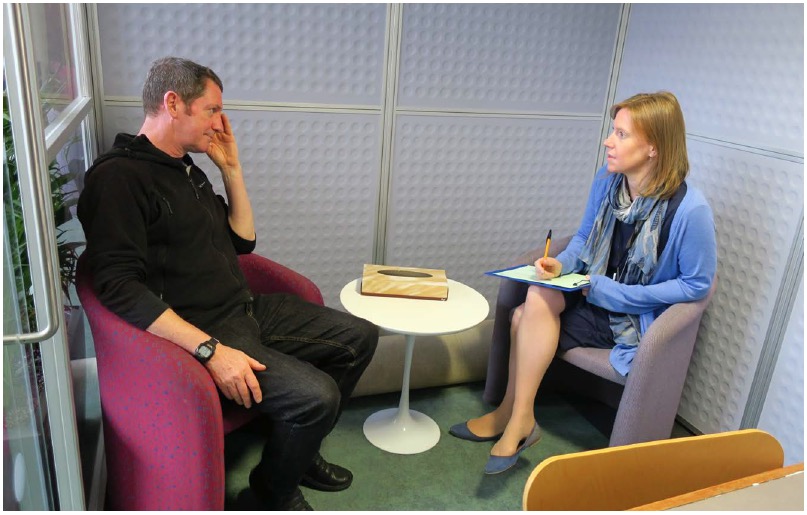Trauma-informed practice: toolkit
This trauma-informed practice toolkit (2021) has now been replaced by the Roadmap for Creating Trauma-Informed and Responsive Change: Guidance for Organisations, Systems and Workforces in Scotland (2023), supported by the National Trauma Transformation Program
Key principle 4: Collaboration
The organisation recognises the value of staff and clients' experience in overcoming challenges and improving the system as a whole. Attempts are made to level the power differentials between different staff groups, and between staff and clients. This principle is often implemented through the formal or informal use of peer support and mutual self-help. There is recognition that healing takes place in the context of relationships and in the meaningful sharing of power and decision-making .
Governance and leadership
Interviewees emphasised the importance of laying groundwork with leaders and managers, and of providing them with information on trauma-informed practice and ways in which it would benefit their organisation. Multiple forums for collaboration were identified, including one-to-one meetings, team away-days and 'debrief days', where staff could speak openly and honestly with managers about their hopes and concerns.
"this is what I come with/want to do. Are you worried about that? Do you have questions about that? Are there things about that you are not sure about?" (CJSW)
The need to target middle managers was highlighted in particular, as collaboration with this level of management was seen to be an essential part of a long-term strategy for embedding trauma-informed practice in the organisation. By training managers to be trauma-informed leaders, it was believed that these managers would become more confident in providing trauma-focused training and supervision to staff, and would model trauma-informed behaviours, such as the appropriate use of self-care.
Where the impetus for trauma-informed practice was primarily coming from management, it was recognised that groundwork also had to be laid among staff groups across all levels of the organisation, in a way that reduced any power differentials.
"I didn't want to patronise people… what I did (which didn't work) was make some assumptions about what their understandings [about trauma] were.
…and afterwards some of the feedback was they didn't know some of that stuff and actually they would have benefited from it…." (CJSW)
Toolkit
? How does organisation leadership show and communicate its support for implementing a trauma-informed approach?
? What is the plan for training provision to be provided to management? This should include examples on how to be a trauma-informed leader – including role modelling?
This was usually done in the context of team meetings or supervision groups, however one case study area described their use of NES trauma training materials in the form of the NES Level 1 trauma animation. This resource was used effectively to facilitate discussion and gain the views of staff on the best way to move the agenda forward. Interviewees commented on how important it was in this context to "nurture relationships as much as possible and work really hard to get people on board".

Policy
Two case study areas described organisational recruitment policies that required trauma-informed practice to be an essential element of job descriptions. Questions relating to trauma-informed practice were also standard in recruitment interviews. Staff in these areas acknowledged that these were policies and procedures that they had not encountered before in their sector.
Toolkit
? How do the organisation's mission statement and/or written policies and procedures include a commitment to providing trauma-informed services and supports?
? How do senior leadership and governance structures demonstrate support for including survivors with experience of using their service in this process (from start to finish)?
Hiring a Trauma-Informed Workforce
Physical environment
The premises of some case study services had kitchen areas connected to the reception, where clients were offered or encouraged to prepare their own tea or coffee on arrival. Clients regularly commented that this experience made them feel that they were being treated with respect.
Attempts were made across case study areas to address the power differentials that can inadvertently be created in physical environments that are not trauma-informed. For example, clients and staff had access to the same kitchen and toilet facilities in most services, and service users and staff both used seating that was of equal height and quality.

Engagement and involvement
Several case study areas made use of formal or informal peer support mechanisms to enhance collaboration. One service described their use of video-conferencing facilities to keep their peer support group running throughout the COVID-19 pandemic. Another case study area developed a peer support group that enabled clients to share their experiences with each other and with staff.
Interviewees described how this group helped to change the perceptions of professionals working in the wider system, represented an empowering experience for the clients involved.
Most case study areas did not make lived experience an essential requirement of the job, however it was recognised that some of the members of the staff team would have their own trauma histories. One case study service described its attempts to reduce the sense of 'them and us' by recruiting a member of staff who had lived experience of a specific type of trauma, as the post in question was designed to work in that particular field of trauma.
Among staff across the case study areas, the routine use of both formal and informal peer support was very evident. A variety of peer support mechanisms were used to build collaborative working, including buddy or mentor systems that paired experienced staff with inexperienced staff where appropriate, and peer support forums which were available face-to-face or online. In some cases, training was provided on how peers could provide support for each other using a psychological first aid framework. Some interviewees also described dedicated time for staff to talk to each other at the end of shifts, or the organising of informal events that enabled staff to support each other through activities unrelated to their work. In this respect it was noted that a key role of leaders was to ensure that staff had access to protected space where they could be together on a regular basis, even for short periods of time.
Some interviewees identified situations, particularly with reference to General Practice, where they felt it was appropriate for staff to be the experts and they described their sense of reliance on this expertise.
"They've got the knowledge and they know what the treatment option would be…what the consequences of that would be." (Speaking about GPs)
Toolkit
? What strategies are used to reduce the sense of power differentials among staff and clients?
Advice on how to use trauma-sensitive language
? How does the physical environment promote a sense of safety, calming and de-escalation for clients and staff?
? What policies and procedures are in place for including trauma survivors/people using services and peer supports in meaningful and significant roles in agency planning, governance, policy making, services and evaluation?
? How do staff members help people to identify strategies that contribute to feeling comforted and empowered?
? How does on-going workforce development/ staff training provide staff supports in developing the knowledge and skills to work collaboratively and effectively with trauma survivors?
Getting Lived Experience on Board
Hiring a Trauma-Informed Workforce
Staff did not think that taking on the role of expert necessarily compromised their ability to work collaboratively. Some staff, for example, spoke about instilling a sense of power-sharing by ensuring that consultations were always focused on the needs and wants of the client. They made a clear differentiation between being a source of knowledge and being a source of authority.
Cross Sector Collaboration
Interviewees commonly emphasised the need for cross sector collaborative working, particularly in cases where the client had complex needs and multiple agencies were involved in the care and support of the individual. In some cases, strong links between agencies were required to facilitate referrals. In others, multi-agency teams were involved in care planning or in the creation of formal links between services operating within the same system.
Senior staff from some of the case study services spoke about the importance of laying the groundwork for cross-sector collaboration. Examples were given of hosting round-table events for key stakeholders in order to underline the purpose and importance of trauma-informed practice. One case study area described initial groundwork that had involved bringing together representatives from community planning in order to secure the buy-in necessary for the subsequent roll out of trauma-informed training across multiple partner agencies.
Toolkit
? Have suitable collaborations been identified? How? Is this process sufficient? Does it cover all bases?
? Is there a system of communication in place with other partner agencies working with the individual receiving services for making trauma-informed decisions?
? Are collaborative partners trauma-informed?
? How does the organisation identify community providers and referral agencies that have experience delivering evidence-based trauma services?
? What mechanisms are in place to promote cross-sector training on trauma and trauma-informed approaches?
Getting Lived Experience on Board
Setting up a Trauma-Informed event
Screening, assessment and treatment
Interviewees across the case study areas described attempts to develop ways of delivering interventions that reflected the trauma-informed principle of collaboration. Most services had adopted person-centred processes that maximised choice and emphasised the position of the service user as an expert by experience.
Staff pointed out that there are some settings that necessitate a hierarchy between service users and providers, citing examples from the fields of education, policing and residential care. In the context of services for children and young people, however, there was evidence of good practice where efforts had been made to share decision-making. Several interviewees spoke about the importance of dialogue between school staff, pupils, and parents, for example, and the need to create a sense that all work would together, driven by a common interest in the welfare of the pupils.
"It's difficult in a school setting but we do try to instil in the pupils a feeling that we are all in this together by talking to them and agreeing steps forward out of a bad situation together."
Staff from another case study area described their efforts to set up mechanisms that would give young people a voice in how they were cared for. Staff frequently described taking a 'doing with, not doing to' approach to working with service users.
"It's about being alongside people…we're not here to tell you what to do, we're here to be alongside them."
Other attempts to recognise the value of service users' experience included the recruitment of staff members with lived experience, and the use of service 'graduates' to deliver support groups. Staff felt that these types of approaches helped to develop a collegiate atmosphere where the line between expert and service user was blurred.
Financing
Across all case study areas, interviewees emphasised the importance of gaining buy-in from their leadership. A common theme was the importance of getting senior management to commit long term to this approach. Reflecting the international literature, some organisations committed to a statement of intent to become trauma-informed.
"It's a five year vision…you're not going to get the results in the first year or two. It's a long term piece of transformational change or culture."(CJSW)
Contact
Email: sharon.glen@gov.scot
There is a problem
Thanks for your feedback